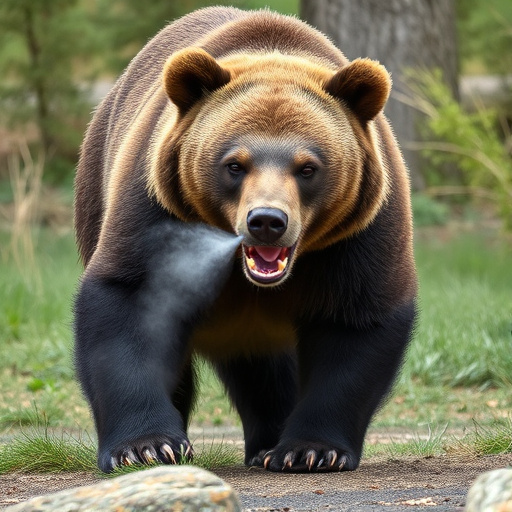Grizzly bear encounters pose a significant risk for outdoor enthusiasts, with charging being a common behavior. While bear spray is an effective deterrent up to 30 feet, wind and terrain conditions can limit its range. Understanding these factors, staying calm, and using bear spray correctly (aiming at the face) are crucial safety measures. Additionally, knowing bear behavior—like appearing larger and speaking loudly—can help deter aggressive encounters.
In the vast wilderness, encountering a charging grizzly bear can be a terrifying experience. Understanding their behavior and having effective defense mechanisms are crucial for safety. This article explores the intricate relationship between these majestic creatures and humans, focusing on bear spray as a key tool. We delve into the science behind cloud dispersal range, providing insights on its effectiveness. Additionally, it offers practical strategies to navigate such encounters, ensuring peace and security in the great outdoors.
- Understanding Grizzly Bear Behavior and Their Charging Patterns
- The Role of Bear Spray in Defense: Mechanism and Efficacy
- Cloud Dispersal Range: How Far Does It Reach and What Does It Mean?
- Effective Strategies for Safety When Confronted by a Charging Grizzly Bear
Understanding Grizzly Bear Behavior and Their Charging Patterns
Grizzly bears, known for their formidable strength and agility, display distinct behavioral patterns when encountering potential threats or prey. Understanding their behavior is crucial for anyone venturing into bear country. These majestic creatures typically avoid human confrontation unless they feel threatened or are protecting their cubs. Their charging behavior, often a cause for concern among outdoor enthusiasts, is usually an attempt to assert dominance or retrieve perceived threats rather than an unprovoked attack.
Charging patterns vary among grizzlies and depend on various factors. Typically, a bear will first make loud noises, huff, and swat the ground to scare off perceived intruders. If this doesn’t deter them, the bear may charge in an attempt to intimidate or capture its target. The cloud dispersal range of bear spray is a significant factor here; it can temporarily incapacitate a bear at close range, providing an escape opportunity for humans. However, it’s important to remember that no deterrent is 100% effective, and awareness of bear behavior remains the best defense in these situations.
The Role of Bear Spray in Defense: Mechanism and Efficacy
Bear spray, also known as bear repellent, is a valuable tool for wilderness enthusiasts and those living in areas with high grizzly bear populations. Its primary function is to create a protective barrier between you and an attacking bear by dispersing an aerosolized solution that bears find unpleasant. When deployed correctly, bear spray creates a cloud of irritants that can reach up to 30 feet (9 meters), providing a safe distance from the bear.
The mechanism behind its effectiveness lies in the active ingredients, which typically include capsaicin, often derived from chili peppers, and other chemicals. These substances irritate the bear’s eyes, nose, and respiratory system, causing them to back away rapidly. The spray’s quick dispersal range allows individuals to defend themselves from a distance, giving them time to escape or climb to safety. Bear spray is considered a non-lethal method of defense, but its effectiveness can be diminished by factors like wind direction and weather conditions, so users must remain vigilant and follow proper usage guidelines.
Cloud Dispersal Range: How Far Does It Reach and What Does It Mean?
The cloud dispersal range of bear spray is a critical factor in understanding its effectiveness as a defense mechanism against charging grizzly bears. This range refers to the distance at which the spray can effectively reach and deter an approaching bear. On average, bear spray clouds can disperse over 30 feet (approximately 9 meters), creating a protective barrier that can stun or scare off an aggressive bear.
The cloud dispersal range is influenced by several factors, including wind speed and direction, terrain, and the specific properties of the spray. In open areas with calm winds, the effective range can extend further, while in tight spaces or when the wind is blowing directly towards the user, the coverage may be reduced. Understanding these variables is crucial for hikers and outdoor enthusiasts to ensure their safety in bear country.
Effective Strategies for Safety When Confronted by a Charging Grizzly Bear
When confronted by an enraged grizzly bear charging towards you, your primary goal is to remain calm and use a combination of deterrents and escape routes. One of the most effective tools in your arsenal is bear spray. Aimed directly at the bear’s face within its cloud dispersal range (typically around 20-30 feet), this spray can create enough irritation for the bear to pause, retreat, or even abandon the attack altogether. It’s crucial to practice using bear spray before venturing into grizzly country and ensure it is accessible during your outdoor activities.
In addition to bear spray, understanding the bear’s behavior can be a valuable strategy. Grizzly bears typically charge when they feel threatened, surprised, or when protecting their cubs or food source. If possible, make yourself appear larger by raising your arms or using a backpack as a barrier. Speak loudly and firmly, letting the bear know you are not an easy target. Slowly back away while facing the bear, giving it an escape route as well. Never run, as it may trigger their chase instinct.
When facing a charging grizzly bear, understanding its behavior and utilizing effective defense strategies are crucial. Bear spray has proven to be a reliable tool, with a cloud dispersal range of up to 30 feet, offering a moment of protection. However, it’s not just about the spray; knowing how to respond during an encounter is vital. By combining awareness, quick actions, and the right tools like bear spray, we can minimize risks when in grizzly bear country. Remember, prevention and understanding their patterns are key to keeping both you and the bears safe.
